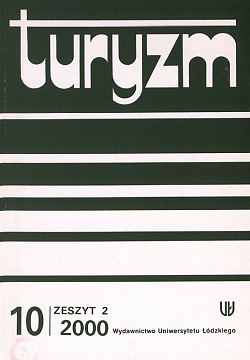Tourist Movement in the Magurski National Park and its Surrounding
DOI:
https://doi.org/10.18778/0867-5856.10.2.02Abstract
The author’s research into tourist movement was directed towards an area of the highest protection status, which in Poland is the national park, with its integral and indispensable part - the buffer zone. The choice of the study subject was not incidental, it is fully justified because of the subjects exceptional character - the Magurski National Park, as the only mountain park in Poland, does not possess any tourist infrastructure (e.g. no accommodation outlets), except marked walking routes. The authors objective was to answer the questions about the characteristics of the tourist movement in the park and its surrounding, about the role of this surrounding as a buffer protecting the park from the excessive inflow of tourists, about the characteristics of the tourists, as well as about the recreational zone of the tourist movement and the national importance of the Magurski National Park. In order to answer all these questions the following aspects were studied: the tourist movement, its forms, seasonality, social-demographic structure, hinterland and, consecutively, its importance. The fact that the results of tourist management (all accommodation outlets and infrastructure designed not only for tourists) can be observed only in the surrounding of the Magurski National Park (except for walking routes), undoubtedly proves that the surrounding of the park performs a tourist function. It is not only the tourist backup to the Park, it is an attraction in itself. This can be proved by the number of Orthodox churches, country and military cemeteries dating back to World War I, as well as the old Lemk cottages. Having observed and analyzed the tourist migrations, one must state that the shape of the Park does not determine the directions of tourist streams, and the marked walking routes sufficiently facilitate the penetration of the Park. The extent to which the accommodation outlets are used shows that they are sufficient in the surrounding area and its importance is regional as far as the intensity of stationary tourism is concerned, and supraregional as far as tourist movement and qualified tourism are concerned. The infrastructure which can be found in the surrounding area is most suitable for typical young tourists-trackers, but it can also be used by w hole families, which can choose from several tourist centres o f a higher standard. The surrounding of the Magurski National Park mainly receives inhabitants of large urban and industrial agglomerations, especially from the nearest voivodships. Its importance, therefore, is regional, with prospects to have a national im portance in the future.
Downloads
References
Boczarow M. K., 1976, Metody statystyki matematycznej w geografii, PAN, Warszawa.
Google Scholar
Garczarczyk J., 1977, Wybrane metody analizy statystycznej. Zbiór zadań, AWF, Warszawa.
Google Scholar
Kamiński L., 1976, Metody badań wielkości ruchu turystycznego. Problemy Ekonomiczne, nr 2.
Google Scholar
Liszewski S., 1990, Funkcja turystyczna Bieszczadów Polskich, Acta Universitatis Lodziensis, Turyzm, nr 6, s. 58-82.
Google Scholar
Matczak A., 1992, Model badań ruchu turystycznego. Studium metodologiczne, Wyd. UŁ, Łódź, s. 3-7.
Google Scholar
Olaczek R., 1979, Wpływ antropopresji na rezerwaty przyrody i parki narodowe. Łódź.
Google Scholar
Ostrowski T., 1975, Ruch turystyczny jako przedmiot badań statystycznych, Sport i Turystyka, Warszawa.
Google Scholar
Ratajski L., 1989, Podstawy kartografii społeczno-ekonomicznej, Warszawa.
Google Scholar
Warszyńska J., 1974, Ocena zasobów środowiska naturalnego dla potrzeb turystyki (na przykładzie woj. krakowskiego), Zeszyty Naukowe UJ, Prace Geograficzne, z. 36.
Google Scholar
Warszyńska J., Jackowski A., 1978, Podstawy geografii turyzmu, PWN, Warszawa.
Google Scholar
Downloads
Published
How to Cite
Issue
Section
License

This work is licensed under a Creative Commons Attribution-NonCommercial-NoDerivatives 4.0 International License.










